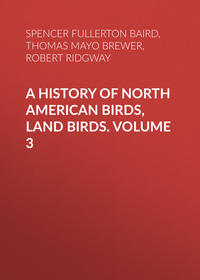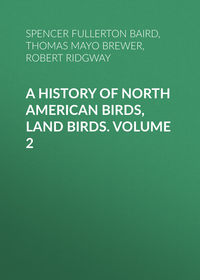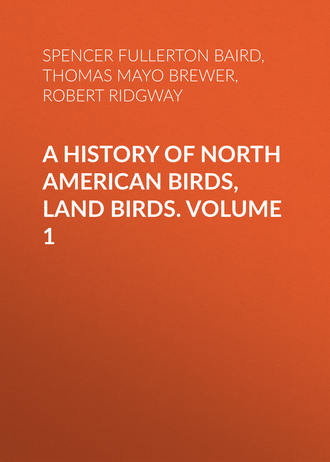 полная версия
полная версияA History of North American Birds, Land Birds. Volume 1
He met with them only in swampy and muddy places, and when opened, he always found their stomachs filled with fragments of coleopterous insects, as well as small green worms, such as are common on water-plants. The habits of this species most resemble those of the Prothonotary Warbler, as the latter skips among the low bushes growing about ponds or in marshy places. It is seldom seen on high trees. Nothing is known as to their nesting or eggs.
Genus HELMINTHOPHAGA, CabanHelminthophaga, Cabanis, Mus. Hein. 1850, 1851, 20. (Type, Sylvia ruficapilla, Wils.)

Helminthophaga ruficapilla.
2238
Gen. Char. Bill elongated, conical, very acute; the outlines very nearly straight, sometimes slightly decurved; no trace of notch at the tip, nor of bristles on the rictus. Wings long and pointed; the first quill nearly or quite the longest. Tail nearly even or slightly emarginate; short and rather slender. Tarsi longer than the middle toe and claw.
The species of this section are well characterized by the attenuation and acuteness of the bill, and the absence of any notch. There are, however, considerable subordinate differences in the different species. In some the bill is larger and more acute than others; in one species, the H. peregrina, the wings are unusually lengthened, the tail being only about seven twelfths as long.
Species and VarietiesCommon Characters. Iris brown. Length about 5.00. Nest on the ground, in grass or dead leaves. Eggs clear white, thickest at end, with minute dots of brown of various shades and faint purple.
A. Tail with a conspicuous patch of white.
a. A black patch covering throat and breast.
1. chrysoptera. Above ash, beneath white. Forehead and a patch on the wing yellow. Hab. Eastern Province of United States, south to Bogota; Cuba.
2. bachmani. Above olive-green; beneath, with forehead, yellow; crown ash, bounded anteriorly with a black bar. No yellow on wing. Hab. South Carolina and Georgia. Cuba in winter.
b. No black on throat or breast.
3. pinus. Above olive-green; beneath, with forehead, yellow; wings ash, with two white bands; lores black. Hab. Eastern Province of United States, south into Guatemala.
B. Tail without a conspicuous white patch.
c. Crown with a concealed patch of rufous (obsolete in ♀).
4. ruficapilla. Above olive-green; head ashy; beneath continuous yellow; a light orbital ring. Hab. North America (very rare in Middle and Western Provinces); Greenland. South to Southern Mexico (Oaxaca, Cordova, Orizaba).
Yellow of throat spreading over cheeks, and staining lores and eyelids. Atlantic States. (Carlisle, Penn., specimens.) … var. ruficapilla.
Yellow of throat confined within the maxillæ; lores and eyelids clear white. Mississippi Valley. (Chicago specimens.) … var. ocularis.
Yellow of throat restricted to a medial stripe, leaving its sides ashy. Middle Province. (Specimen from Fort Tejon, Cal., and East Humboldt Mountains, Nevada.) … var. gutturalis.
5. virginiæ. Above ash to the rump, beneath white. A patch on the jugulum, with the upper and lower tail-coverts, yellow. Hab. Rocky Mountains of United States, west to East Humboldt Mountains.
6. luciæ. Above ash, beneath continuous white. Upper tail-coverts chestnut. Hab. Colorado region of Middle Province.
7. celata. Above continuous olive-green, below continuous pale yellow. (Orange on crown in ♂ only?)
Above ashy-olive, beneath yellowish olivaceous-white; inner webs of tail-feathers broadly edged with white. (Middle regions of North America; Mexico.) … var. celata.
Above greenish-olive, beneath bright greenish-yellow; white edges to inner webs of tail-feathers obsolete. (Pacific Province of North America.) … var. lutescens.
Similar to var. celata, but plumage darker and more dingy. No white edgings to tail-feathers, and apparently no rufous on the crown in either sex. (Georgia, Florida, etc.) … var. obscura.
d. No rufous on crown.
8. peregrina. Above olive-green; head and neck pure ash; beneath continuous white. Hab. Eastern Province of North America north to Fort Simpson, H. B. T. south to Panama. Cuba (rare).
Helminthophaga chrysoptera, CabanGOLDEN-WINGED WARBLERMotacilla chrysoptera, Linn. S. Nat. I, 1766, 333. Sylvia chr. Lath.—Wils. Am. Orn. II, pl. xv. fig. 5.—Bon. Sylvicola chr. Bon. Helinaia chr. Aud. Birds Am. II, pl. cvii. Helmitherus chr. Bon.—Sclater, P. Z. S. 1855, 143 (Bogota). Helminthophaga chrysoptera, Cab. Mus. Hein.; Journ. f. Orn. 1860, 328 (Costa Rica).—Baird, Birds N. Am. 1858, 255; Rev. 175.—Sclater & Salvin, Ibis, II, 1860, 397 (Choctum, Guatemala).—Salvin, 1867, 135.—Dresser, Ibis, 1865, 477 (San Antonio).—Lawrence, Ann. N. Y. Lyc. VII, 1861, 293 (Panama).—Gundl. Cab. Journ. 1861, 326 (Cuba, rare). Motacilla flavifrons, Gmelin. Sylvia flavifrons, Lath.

Helminthophaga celata.
Sp. Char. Upper parts uniform bluish-gray; the head above and a large patch on the wings yellow. A broad streak from the bill through and behind the eye, with the chin, throat, and forepart of the breast, black. The external edge of the yellow crown continuous with a broad patch on the side of the occiput above the auriculars, a broad maxillary stripe widening on the side of the neck, the under parts generally, with most of the inner webs of the outer three tail-feathers, white; the sides of the body pale ash-color. Female similar, but duller. Length about 5 inches; wing, 2.65; tail, 2.25.
Hab. Eastern Province of United States, San Antonio (Dresser); Cuba (rare); Guatemala; Costa Rica; Panama; Bogota. Recorded in West Indies from Cuba only; not from Mexico. Veragua; Chiriqui (Salvin).
Habits. So far as our present knowledge of this Warbler extends, it is nowhere a common species, and is distributed over a comparatively small extent of territory. Wilson met with it in Pennsylvania during the last of April and the first of May, believing it to be only a migrant species on its way to more northern regions. Nuttall was sceptical of these conclusions, as he never met with the species in the New England States. Audubon observed these birds in their migrations through Louisiana, which State they entered from Texas in the month of April. He procured several specimens in Louisiana and Kentucky, and one in New Jersey. He knew nothing as to its breeding, and seems to have accepted Wilson’s inferences in regard to its northern migrations. He never met with this bird in the fall, when, if a Northern species, it should be returning south, and thence inferred that it migrated by night.
Professor Baird has obtained this bird near Carlisle, Penn., in July, rendering probable its breeding in that vicinity. W. S. Wood met with it near St. Louis, May 13, 1857, and two days previously in the same year Mr. Kennicott procured an individual in Southern Illinois. Occasionally specimens have been obtained in Massachusetts, and of late these occurrences have become more frequent or more observed. It was first noticed near Boston by J. Eliot Cabot, Esq., who shot one in May, 1838, near Fresh Pond. This was, he thinks, on the 20th of that month. Since then Mr. J. A. Allen has known of several specimens taken within the State. Mr. Jillson has observed it spending the summer in Bolton, and evidently breeding, as has also Mr. Allen at Springfield, and Mr. Bennett at Holyoke. In the summer of 1870, Mr. Maynard obtained its nest and eggs in Newton.
The late Dr. Gerhardt found it breeding among the high grounds of Northern Georgia. It has also been taken at Racine, Wis., by Dr. Hoy, and in Ohio. These data seem to show that it is sparingly found from Georgia to Massachusetts, and from New Jersey to Missouri and Wisconsin. Its western limits may be more extended. It was not met with by any of the exploring parties beyond St. Louis, but its retiring habits and its sparse distribution may account for this.
Dr. Samuel Cabot was the first naturalist to meet with the nest and eggs of this bird. This was in May, 1837, in Greenbrier County, Va. The nest was constructed in the midst of a low bush on high ground, and contained four eggs.
The late Dr. Alexander Gerhardt found the nest and eggs of this Warbler in the spring of 1859, in Whitfield County, Ga. It contained four eggs, and was built on the ground. It was very large for the bird, being five inches in height and four in diameter. The cavity was also quite large and deep for so small a bird, exceeding three inches both in depth and in diameter. The outer and under portions of this nest were almost entirely composed of the dry leaves of several kinds of deciduous trees. These were interwoven with and strongly bound together by black vegetable roots, dry sedges, and fine strips of pliant bark, and the whole lined with a close network of fine leaves, dry grasses, and fibrous roots. Dr. Gerhardt informed me that these birds usually build on or near the ground, under tussocks of grass, in clumps of bushes, or pine-brush, and that they lay from four to five eggs, from the 6th to the 15th of May.
The eggs of this species are of a beautiful, clear crystal-white, with a few bright reddish-brown spots around the larger end. Eggs from Racine, Wis., and from Northern Georgia, differ greatly in their relative size. The former measure .70 of an inch in length and .53 in breadth; the latter, .63 by .49.
A single specimen of this species was obtained by Mr. Salvin, at Choctum, in Guatemala.
Helminthophaga bachmani, CabanBACHMAN’S WARBLERSylvia bachmani, Aud. Orn. Biog. II, 1834, 483, pl. clxxxiii. Sylvicola b. Rich. Vermivora b. Bon. Helinaia b. Aud. Syn. Birds Am. II, 1841, 93, pl. cviii.—Lembeye, Av. Cuba, 1850, 36, pl. vi. fig. 1. Helmitherus b. Bon. Helminthophaga b. Cab. Jour. III, 1855, 475 (Cuba, in winter).—Baird, Birds N. Am. 1858, 255; Rev. 175.—Gundlach, Cab. Jour. 1861, 326 (Cuba, rare); Repert. 65, 232.
Sp. Char. Above olive-green, as also are the sides of the head and neck. Hind head tinged with ash. A broad patch on the forehead, bordered behind by black; chin, stripe from this along the side of the throat, and the entire under parts, deep yellow. Throat and forepart of breast black. A patch on the inner web of the outer two tail-feathers near the end white. Length, 4.50; wing, 2.35; tail, 2.05. Female with merely a patch of dusky on the jugulum, and with the black bar on vertex obsolete.
Hab. Coast of South Carolina and Georgia; Cuba in winter.
Habits. Bachman’s Warbler is a comparatively new and but little known species of this interesting group. It was first discovered, July, 1833, by Rev. Dr. John Bachman, a few miles from Charleston, S. C., and in the same vicinity he afterwards discovered a few others of both sexes. He described it as a lively, active bird, gliding among the branches of the thick bushes, occasionally mounting on the wing and seizing insects in the air, in the manner of a Flycatcher. The individual first obtained was an old female which had, to all appearances, just reared a brood of young. With this partial exception, nothing is known in relation to its habits. As all the species of this genus, without any at present known exception, construct their nests upon the ground, it is a natural inference that it probably nests in a similar situation.
The Smithsonian Institution possesses but a single specimen of this bird, obtained near Charleston, S. C. It was not observed by any naturalist of the several governmental exploring expeditions, and, so far as we are at present informed, its only known places of abode are South Carolina and Cuba, where it is extremely rare. Its nest and eggs still remain unknown.
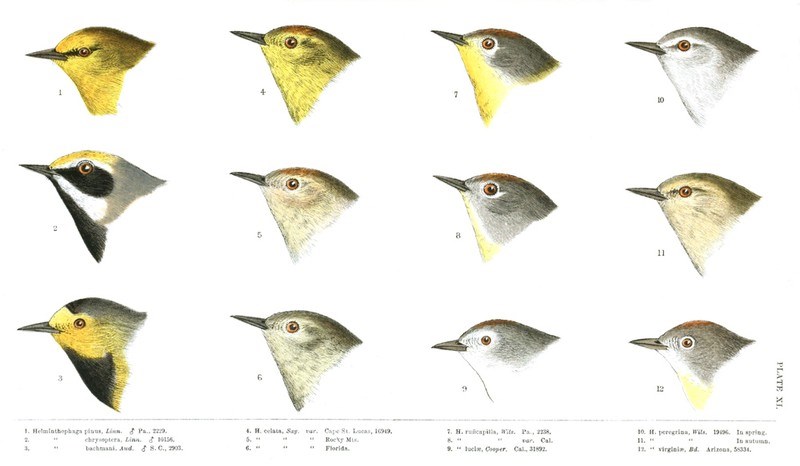
PLATE XI.

1. Helminthophaga pinus, Linn. ♂ Pa., 2229.

2. Helminthophaga chrysoptera, Linn. ♂ 10156.
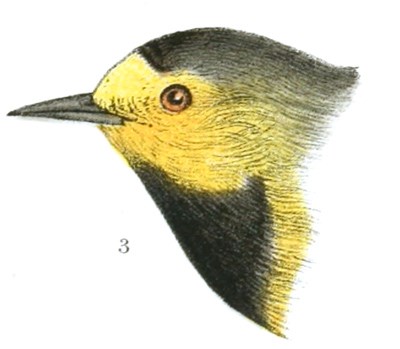
3. Helminthophaga bachmani, Aud. ♂ S. C., 2903.

4. Helminthophaga celata, Say. var. Cape St. Lucas, 16949.
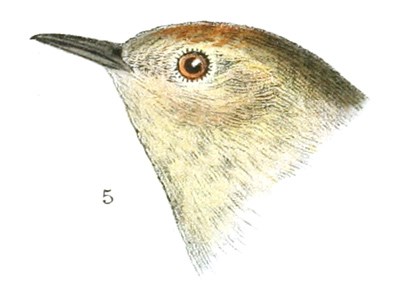
5. Helminthophaga celata, Say. var. Rocky Mts..
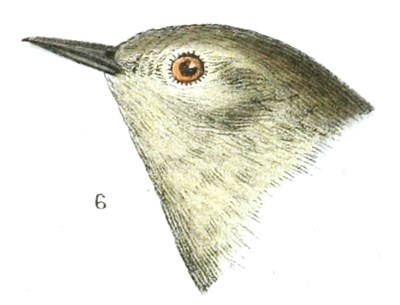
6. Helminthophaga celata, Say. var. Florida.
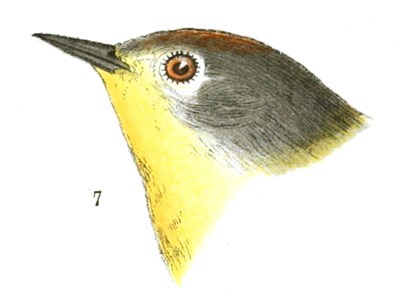
7. Helminthophaga ruficapilla, Wils. Pa., 2238.

8. Helminthophaga ruficapilla, Wils. var. Cal.
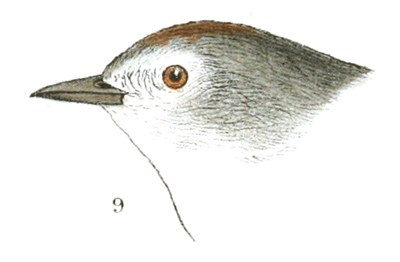
9. Helminthophaga luciæ, Cooper. Cal., 31892.
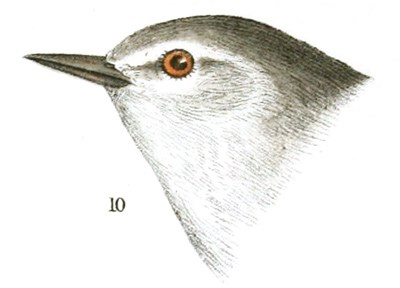
10. Helminthophaga peregrina, Wils. 19496. In spring.
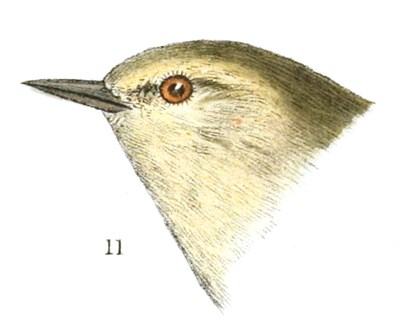
11. Helminthophaga peregrina, Wils. In autumn.
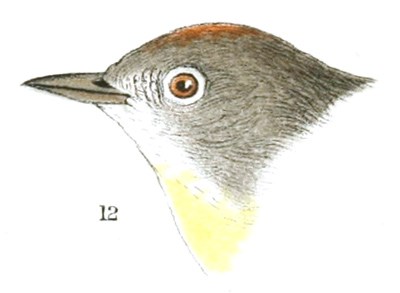
12. Helminthophaga virginiæ, Bd. Arizona, 58334.
Helminthophaga pinus, BairdBLUE-WINGED YELLOW WARBLER
Certhia pinus, Linn. Syst. Nat. I, 1766, 187. Sylvia pinus, Lath., Vieill. (not of Wilson). Helminthophaga pinus, Baird, Birds N. Am. 1858, 254; Rev. 174.—Sclater & Salvin, Ibis, 1, 1859, 11 (Guatemala).—Sclater, Catal. 1861, 28, No. 176. Sylvia solitaria, Wilson, Am. Orn. II, pl. xv.—Aud. Orn. Biog. I, pl. xx. Sylvicola sol. Rich. Vermivora sol. Sw. Helinaia sol. Aud. Birds Am. II, pl. cxi. Helmitherus sol. Bon.—Sclater, P. Z. S. 1856, 291 (Cordova). Helminthophaga sol. Cab.
Sp. Char. Upper parts and cheeks olive-green, brightest on the rump; the wings, tail, and upper tail-coverts, in part, bluish-gray. An intensely black patch from the blue-black bill to the eye, continued a short distance behind it. Crown, except behind, and the under parts generally, rich orange-yellow. The inner wing and under tail-coverts white. Eyelids, and a short line above and behind the eye, brighter yellow. Wing with two white bands. Two outer tail-feathers with most of the inner web, third one with a spot at the end, white. Female and young similar, duller, with more olivaceous on the crown. Length, 4.50; wing, 2.40; tail, 2.10.
Hab. Eastern United States and Mexico to Guatemala (Cordova; Coban). Not noted from West Indies.
Habits. The Blue-winged Yellow Warbler is not known so far to the north as New England, and is rare even in Eastern and Southern New York. It seems to be distributed through the United States from Pennsylvania to Florida, and from the Mississippi Valley eastward. It has also been taken in Central America. Mr. Trippe states that it breeds in the vicinity of Orange, N. Y. Mr. Audubon found it abundant in the barrens of Kentucky, and as far north on the Mississippi as St. Genevieve.
In regard to the song of this bird, Mr. Trippe states that its notes are very forcible and characteristic. Once heard, they will always be remembered. He describes them as a rapid chirrup resembling chūūchich, k´-a-re-r´r´r´r´r, uttered very quickly. According to Mr. Ridgway, they are wonderfully similar to the rude lisping chirrup of the Coturniculus passerinus.
Wilson says that these Warblers come from the South early in May, frequenting thickets and shrubberies in search of insects, which they seek in the branches. They are also fond of visiting gardens and orchards, gleaning for insects among the low bushes. They generally build their nests on the edge of sequestered woods. These Mr. Wilson states to have been, in every instance observed by him, fixed on the ground, in a thick tussock of long grass, and built in the form of an inverted cone, the sides being formed of the dry bark of strong fibrous weeds lined with fine dry grasses. These materials, he remarks, are not arranged in the usual circular manner, but shelve downward from the top, the mouth being wide and the bottom narrow. He describes the eggs as five in number, pure white, with a few faint dots of reddish near the larger end. The young appear the first week in June. The nests were always in an open but retired part of the woods, and were all as thus described.
According to Mr. Audubon its song consists of a few weak notes that are by no means interesting. His description of its nest agrees with that of Wilson. He states that it usually has two broods in the season, one in May, the other in July. The young disperse as soon as they are able to provide for themselves.
He describes them as of solitary habits, and adds that they leave Louisiana for the South early in October. Its flight is short, undetermined, and performed in zigzag lines. It will ascend twenty or thirty yards in the air as if about to go to a greater distance, when, suddenly turning round, it will descend to the place from which it set out. It rarely pursues insects on the wing, feeding chiefly on the smaller kind of spiders, and seizing other insects as they come within its reach.
The above accounts of its breeding, and especially of its nest, do not correspond with the observations of Mr. Ridgway, near Mt. Carmel, Ill., where the bird is abundant. A nest collected by him is a very loose open structure, composed chiefly of broad, thin, and flexible strips of the inner bark of deciduous trees, chiefly the bass-wood. It contained five eggs, and was obtained May 8. It was first discovered by noticing the bird with materials in her bill. The situation of this nest “was in no wise,” says Mr. Ridgway, “as described by Wilson, not having any covered entrance.” The nest was very bulky, and so loosely made that only the inner portion could be secured. “I have found other nests,” adds Mr. Ridgway, “all corresponding with this one. There can be no doubt as to its identity, as the birds were seen building the nest, and were closely watched in their movements. Both male and female were seen several times.” (No. 10,140, Smith. Coll.)
The eggs of this species measure .70 of an inch in length by .53 in breadth. Their aground-color is white, sprinkled with a few reddish-brown spots.
Helminthophaga ruficapilla, BairdNASHVILLE WARBLERSylvia ruficapilla, Wils. Am. Orn. III, 1811, 120, pl. xxvii, fig. 3.—Aud. Orn. Biog. I, 1832, 450, pl. lxxxix. Helminthophaga ruficapilla, Baird, Birds N. Am. 1858, 256; Rev. 175.—Sclater, P. Z. S. 1859, 373 (Xalapa).—Dresser, Ibis, 65, 477 (Texas).—Cooper, Orn. Cal. 1, 1870, 82. Sylvia rubricapilla, Wils. Am. Orn. VI, 1812, 15, General Index.—Nutt., Bon. Sylvicola rub. Rich. Vermivora rub. Bon.—Reinhardt, Vid. Med. for 1853, 1854, 82 (Greenland).—Brewer, Pr. Bost. Soc. N. H. VI, 1856, 4 (nest and eggs). Helinaia rub. Aud. Birds Am. II, pl. cxiii. Helmitherus rub. Bon.—Scl. P. Z. S. 1856, 291 (Cordova); 1859, 363 (Xalapa). Helminthophaga rub. Cab.—Sclater, P. Z. S. 1858, 298 (Oaxaca; Feb. and Aug.). Mniotilta rub. Reinhardt, Ibis, 1861, 6 (Greenland). Sylvia leucogastra, Shaw, Gen. Zoöl. X, II, 1817, 622. “Sylvia nashvillei,” Vieillot.—Gray. Sylvia mexicana, Holböll.
Sp. Char. Head and neck above and on sides ash-gray, the crown with a patch of concealed dark brownish-orange hidden by ashy tips to the feathers. Upper parts olive-green, brightest on the rump. Under parts generally, with the edge of the wing, deep yellow; the anal region paler; the sides tinged with olive. A broad yellowish-white ring round the eye; the lores yellowish; no superciliary stripe. The inner edges of the tail-feathers margined with dull white. Female similar, but duller; the under parts paler, and with more white; but little trace of the red of the crown. Length, 4.65; wing, 2.42; tail, 2.05.
Hab. Eastern Province of North America; rare in the Middle Province (Fort Tejon, Cal., and East Humboldt Mountains, Nev.); Greenland (Reinhardt); Oaxaca (February and August, Sclater); Xalapa and Cordova (Sclater); Orizaba (winter, Sumichrast). Not recorded from West Indies.
It is an interesting fact, that, in this species, we find in the yellow a tendency to become more and more restricted as we pass westward. In adult spring males from the Atlantic States this color invades the cheeks, and even stains the lores and eyelids. In two adult spring males from Chicago it is confined within the maxillæ, the cheeks being clear ash, and the loral streak and orbital ring pure white; while in an adult male (autumnal, however) from the East Humboldt Mountains (Nevada, No. 53,354, U. S. Geol. Expl., 40th par.) the yellow is restricted to a medial strip, even the sides of the throat being ashy; the ash invades the back too, almost to the rump, while in Eastern specimens it extends no farther back than the nape. A male (No. 10,656, J. Xantus) from Fort Tejon, Cal., is much like the Nevada specimen, though the peculiar features of the remote Western form are less exaggerated; it is about intermediate between the other specimen and the specimens from Chicago. As there is not, unfortunately, a sufficiently large series of these birds before us, we cannot say to what extent these variations with longitude are constant.
Habits. The Nashville Warbler appears to be a species of somewhat irregular occurrence; at one time it will be rather abundant, though never very numerous, and at another time comparatively rare. For a long while our older naturalists regarded it as a very rare species, and knew nothing as to its habits or distribution. Wilson, who first met with it in 1811, never found more than three specimens, which he procured near Nashville, Tenn. Audubon only met with three or four, and these he obtained in Louisiana and Kentucky. These and a few others in Titian Peale’s collection, supposed to have been obtained in Pennsylvania, were all he ever saw. Mr. Nuttall at first regarded it as very rare, and as a Southern species. In that writer’s later edition he speaks of it as a bird having a Northern distribution as far as Labrador. Dr. Richardson records the occurrence of a single straggler in the fur country. So far as known, it occurs as a migrant in all the States east of the Missouri, and is a summer resident north of the 40th parallel. It probably breeds in the high ground of Pennsylvania, though this fact is inferred rather than known. It breeds in Connecticut and Massachusetts, and in Maine in the vicinity of Calais, being more abundant there than anywhere else, as far as has been ascertained.
Two individuals of this species have been taken in Greenland: one at Godthaab, in 1835; and the other at Fiskenæsset, August 31, 1840.
In Massachusetts it has so far been found in only a few restricted localities, Andover, Lynn, and Hudson, though it undoubtedly occurs elsewhere. About the time Wilson obtained his first specimen, a living bird of this species flew into the parlor of the late Colonel Thomas H. Perkins of Brookline, and is now in the collection of his grandson, Dr. Cabot. The latter gentleman states that when he first began making collections this Warbler was a very rare visitant to his neighborhood, but has of late become much more common, though varying greatly in this respect in different seasons. Specimens have been obtained in Western Iowa by Mr. H. W. Parker, of Grinnell.




